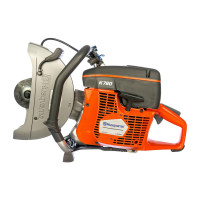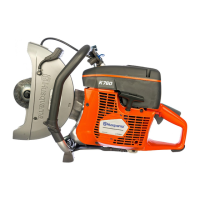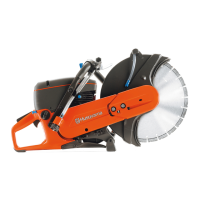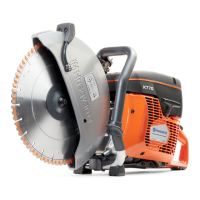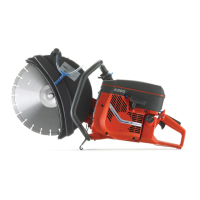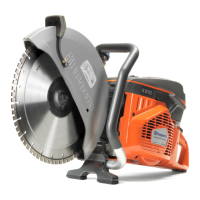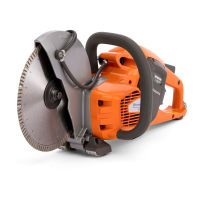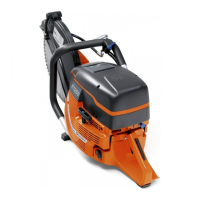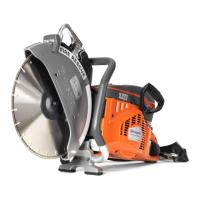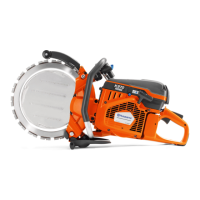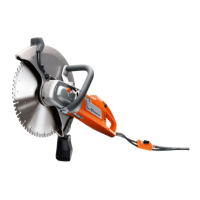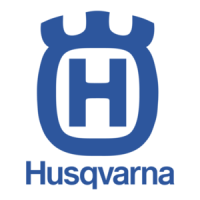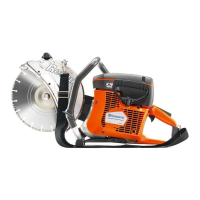
Do you have a question about the Husqvarna K 760 Cut-n-Break and is the answer not in the manual?
| Engine type | 2-stroke |
|---|---|
| Displacement | 73.5 cm³ |
| Power output | 3.7 kW |
| Weight | 9.6 kg |
| Max cutting depth | 400 mm |
| Fuel tank volume | 0.9 l |
| Sound pressure level at operator's ear | 101 dB(A) |
| Idle speed | 2800 rpm |
Describes safety and operational symbols used on the machine, including warnings and essential icons.
Details the different warning categories (Warning, Caution, Notice) and their implications for user safety.
A welcoming message and introduction to the Husqvarna product, emphasizing satisfaction and support.
Highlights the key technological and performance features of the machine, such as Active Air Filtration and Dura Starter.
Outlines the operator's and employer's duties for safe and proper machine use, including understanding the manual.
Notes the company's policy of continuous product development and the right to modify designs without prior notice.
Identifies and labels all components of the power cutter with corresponding numbers for easy reference.
Broad safety advice and checks applicable to the machine, emphasizing never using faulty safety equipment.
Explains the throttle lockout mechanism's function and how to test its proper operation.
Describes the function of the stop switch for engine shutdown and how to verify its operation.
Emphasizes the importance and mandatory inspection of blade guards before starting the machine.
Details the vibration reduction system designed to minimize user exposure and its periodic checks.
Discusses the muffler's role in noise reduction and fire safety, warning about its heat during operation.
General warnings and best practices for using blades, stressing the use of original, sharp, and undamaged blades.
Explains the critical role of continuous water cooling for blade performance, longevity, and dust prevention.
Guidance on maintaining blade sharpness by cutting soft materials to prevent overheating and damage.
Advice on inspecting new blades for any damage before transport or storage.
Information on selecting the correct blade hardness for specific materials like masonry or reinforced concrete.
Safety precautions for handling fuel and avoiding hazards like fire, explosion, and carbon monoxide poisoning.
Details on recommended fuel types, octane ratings, and the risks associated with low-octane fuel.
Guidance on selecting and using the correct Husqvarna two-stroke oil for optimal performance.
Instructions and precise ratios for preparing the fuel-oil mixture, including recommended mixing steps.
Safe procedures for refueling the machine, including engine shutdown and handling fuel spills.
Guidelines for safely transporting and storing fuel containers to prevent leaks and fumes.
Procedure for emptying the fuel tank and proper storage of the machine for extended periods.
Lists essential personal protective equipment (PPE) required for safe operation, including helmet and gloves.
Mentions additional safety items such as a first aid kit and fire fighting equipment.
Basic safety directions for operating the machine, emphasizing reading the manual and operator responsibility.
Emphasizes exercising caution, awareness, and seeking expert advice when in doubt during operation.
Reiterates the importance of water cooling for blades and mentions the water flow restrictor.
Safety measures for the surrounding environment, including maintaining a safety distance and clear visibility.
Demonstrates fundamental cutting methods, blade angle, and material removal techniques.
Explains the phenomenon of kickback, its causes, and its potential for serious or fatal injuries.
Details the specific actions, like cutting in the kickback zone, that lead to kickback.
Reinforces essential operational guidelines such as grip, balance, and avoiding specific cutting directions.
Describes the issue of pull-in, where blades stop suddenly, and methods to avoid it.
Explains blade jamming due to cut closure and its potential for powerful machine jerks.
Provides techniques to prevent blade pinching by supporting the workpiece to keep the cut open.
Guidelines for safely transporting and storing the machine, securing it to prevent damage and accidents.
Crucial pre-start checks, including reading the manual, wearing PPE, and ensuring no unauthorized persons are present.
Step-by-step instructions for starting the power cutter, including using the decompression valve and choke.
Procedures for safely shutting down the engine, warning about blade coasting after motor stop.
General warnings and responsibilities for performing maintenance, emphasizing authorized service for extensive work.
Outlines regular maintenance tasks (daily, weekly, monthly) for various machine components.
Instructions for cleaning the machine's exterior and cooling air intake after use.
Troubleshooting and maintenance of the spark plug, including checking the electrode gap and cleaning.
Basic checks for nuts, screws, and the general condition of the machine's components.
Procedure for replacing the cutting blades, noting they must be changed in pairs.
Details on checking drive belt tension, adjusting it, and replacing the belt.
Safety warnings and steps for starter cord replacement, emphasizing caution with recoil springs.
Troubleshooting advice for engine performance issues related to the carburettor.
Procedure for setting the correct idle speed to ensure the cutting blade remains stationary.
Steps for properly tensioning the starter recoil spring to ensure reliable starting.
Procedure for replacing a broken recoil spring, with warnings about spring tension.
Instructions for correctly installing the starter assembly onto the crankcase.
Checks for fuel cap, seal, and fuel hose integrity to prevent leaks and contamination.
Information on the fuel filter's location, cleaning restrictions, and replacement schedule.
Guidance on when to inspect or replace the air filter, typically when engine power drops.
Specific instructions for removing the cover and replacing the air filter.
Checks for wear on the drive gear and clutch components, including the clutch spring.
Maintenance of the water tap, including checking and cleaning the restrictor if necessary.
Specifications for the engine, including displacement, bore, stroke, and speed ratings.
Details on the ignition system manufacturer, type, and spark plug specifications.
Specifications for the carburettor, fuel tank capacity, and electrode gap.
The dry weight of the machine without fuel.
Data on sound power levels measured and guaranteed, according to EC directives.
Equivalent sound pressure level at the operator's ear and vibration levels for handles.
Vibration data (a hveq) measured for front and rear handles.
Specifications related to the cutting blade, gear ratio, and maximum cutting depth.
Declaration of compliance with EU directives for machinery, EMC, and noise emissions.
